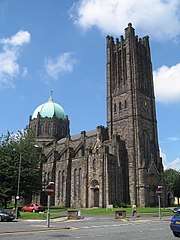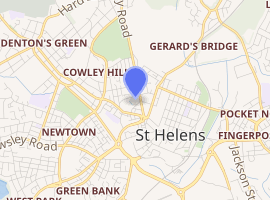Church of St Mary, Lowe House
The Church of St Mary, Lowe House is a Roman Catholic Parish church situated on North Road in St Helens, Merseyside. The present church was founded in 1924 and staffed by the Society of Jesus until 1981. It is a Grade II listed building with Romanesque and Gothic features.[2]
| Church of St Mary, Lowe House | |
|---|---|
 South side of the church | |

| |
| OS grid reference | SJ5093595844 |
| Location | St Helens, Merseyside |
| Country | United Kingdom |
| Denomination | Roman Catholic |
| Website | https://www.stmaryslowehouse.org |
| History | |
| Status | Active |
| Founded | 1924 |
| Architecture | |
| Functional status | Parish church |
| Heritage designation | Grade II listed |
| Designated | 11 September 1951 |
| Architect(s) | Charles B. Powell[1] |
| Administration | |
| Parish | St Mary's and St. Thomas of Canterbury |
| Deanery | St Helens – St Monica Pastoral Area |
| Archdiocese | Liverpool |
| Province | Liverpool (aka Northern) |
| Clergy | |
| Archbishop | Most Rev. Malcolm McMahon O.P. |
| Priest(s) | Rev. Thomas Gagie |
History
Origin
The church is named St Mary's Lowe House because it was built on a piece of land that was occupied by Lowe House. It was given in 1793 by Winefred Eccleston née Lowe, the widow of John Gorsuch Eccleston, the owner of Eccleston Hall, in Eccleston, outside St Helens.[3] This is where the first church was built. It was enlarged three times, the final time being in 1857.[4]
Foundation
To accommodate the growing Catholic population in the town, a new church was built in 1924 by the side of the original church (which was eventually demolished in 1930). The foundation stone was laid by the Archbishop of Liverpool, Frederick Keating on 11 May 1924. The scale was decided on by Fr Reginald Riley SJ, who wanted a larger size church for the local Catholic community. He was parish priest at the church from 1912 to 1946.[3] The church was opened three years later, in 1929, and was designed by Charles B. Powell,[1] an Irish architect who did other architectural work for the Jesuits in Dublin. It is colloquially referred to as 'The Basilica of St Helens' and 'The Poor Man's Cathedral' by people in St Helens, because construction of the church was funded by donations from the local population during a time of economic struggle.[3]
The dome, designed in a Romanesque crossed with Gothic style, is on the point where the nave, sanctuary and transepts meet, sitting on a castellated octagonal tower. There is a copper cross on the dome that is 16 feet high. It was given to the church by the family of a local builder, James Yearsley whose company helped lay the foundations.[3] The clock face on the 130 ft tall tower is set in gold mosaic.
Carillon
A major feature of the clock tower is the historic Carillon (bells playable in musical notation by a keyboard, rather than in sequences by ropes)[3]. Cast and built by renowned bellfounders John Taylor & Co. of Loughborough, it is the largest in the North West of England housing 47 bells.[5] The Carillon is regularly played and there are also occasional recitals by visiting Carillonneurs.
Parish
Every week, the church has two Masses every Sunday, one at 11:00 am and the other at 4:30 pm. Also, there are Masses at 9:15 am on Tuesdays and Thursdays.
On 27 July 1980, the head of the Jesuits in Britain announced to the congregation that, as of Easter 1981, the church would no longer be staffed by Jesuits and would be handed over to the Archdiocese of Liverpool.[6]
In 2010, the parish was merged with the nearby Holy Cross and St Helen parish in the centre of St Helens to become the parish of Holy Cross and St Mary. However in 2014, following changes in the archdiocese, St Mary's Lowe House was paired with the parish of St Thomas of Canterbury, Dentons Green. The church of Holy Cross & St. Helen reverted to a single parish under a new parish priest.
Gallery
- Memorial stone for Winefred Eccleston
- Nave
- Entrance
%2C_St._Helens_-_geograph.org.uk_-_1541687.jpg) Interior
Interior
See also
References
- Dictionary of Irish Architects. Retrieved 15 August 2013
- British listed buildings. Retrieved 14 August 2013
- https://www.stmaryslowehouse.org/history
- St. Mary's, Lowe House Diamond Jubilee Commemorative Brochure 1989 p.3
- "St Mary's Lowe House Carillon". British Carillon Society.
- Society of Jesus (December 1980). "Province News". Letters and Notices. 84: 133.
External links
| Wikimedia Commons has media related to St Mary's Lowe House, St Helens. |
